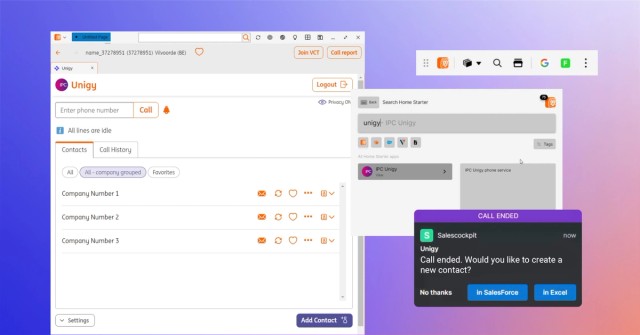November 6, 2018
Top 3 Tips for Improving Fixed Income Trading Workflow Efficiencies

This blog was first published on Tabb Forum, November 6th 2018
Desktop interoperability solutions allow financial applications to communicate with each other and share context and intent in a permissioned manner. Instead of trying to repackage everything into one new system, these solutions focus on opening up connections so existing systems can speak to one another, allowing for new levels of collaboration and efficiency. But what should firms be on the lookout for when assessing intercommunication systems?
It only takes a cursory glance at this year’s Fixed Income Leaders Summit agenda in Amsterdam to perceive the extent of how technology, electronification and digitisation have become main talking points of the fixed income industry. And while shiny new fintech solutions such as AI and machine learning are being hailed as saviours to workflow efficiencies, they are not much good if information cannot be efficiently passed through internal systems in the first place.
Today’s traders have access to thousands of apps designed to ease their workflow, yet they have to constantly switch between platforms and re-enter information, leading to costly inefficiencies as well as human error. The problem is that getting all these apps – order management systems, market data, TCA analytics, visualisation, charting or messaging – to interoperate seamlessly is no easy task.
A legacy of problems
Deploying fintech solutions with banks and brokers presents a number of challenges, driven by issues relating to security and legacy infrastructures. When each bank, buy-side firm, and vendor has its own in-house or vendor-built desktop framework, applications are not able to automatically talk to each other.
For example, currently, the process of identifying potentially lucrative bonds and subsequently investigating historical and current inventory availability needs to be performed manually. This re-keying of information from one system to another not only prohibits the trader from working at speed, but leaves him or her open to “fat finger” errors.
In order for information to efficiently pass through an investment management system, siloed information technology operations need to be seamlessly joined up. Previous solutions of having one costly “super system” are being challenged, either because past attempts at complete integration proved to be elusive, or software soon became out of date and more specialised vendors appeared.
However, “desktop interoperability” solutions are already available today, allowing financial applications to communicate with each other and share context and intent in a permissioned manner. Instead of trying to repackage everything into one new system, these solutions focus on opening up connections so existing systems can speak to one another, allowing for new levels of collaboration and efficiency. This intercommunication is achieved by the simple layering of code on top of existing programmes, providing an extremely flexible and adaptable solution to which new programmes can be constantly added.
Top 3 tips for improving workflow efficiencies
But what should firms be on the lookout for when assessing intercommunication systems? Here are our top three tips for workflow efficiencies beneficial to fixed income trading desks:
- Desktop interoperability: Interoperability is the key to solving workflow efficiency problems. Just as Apple products allow for seamless manoeuvring across programmes from a wide variety of third-party developers, operating systems ideally need a multitude of apps encompassing a host of supporting applications for compliance, risk management and related corporate areas. This allows traders to select the very best applications necessary for their specific workflow and make full use of the technology at their disposal, without sacrificing any time to the inconveniences that so often come with it.
- Collaborative & innovative ecosystem: Interoperability solutions need to create not only an ecosystem of apps, the developers of those apps need to prize collaboration and innovation above all in order to contribute to an efficient and context-aware desktop. Partnerships and collaboration between specialist vendors will be very powerful.
- Common standards: Industry-wide standards need to be in place to allow financial applications to interoperate and communicate with each other, similar to how the FIX Protocol standardised the exchange of information and data for the trader desktop 20 years ago. Rather than waste time and money performing expensive bespoke integrations, firms can employ common messaging standards to ensure smooth implementations for all parties involved. The Financial Desktop Connectivity and Collaboration Consortium, or FDC3, initiative was formed last year to “enable faster decision-making, improve productivity and streamline workflow.” The project describes itself as a “unifying and application-agnostic” system that aims to unite information and make finance easier with more than 50 firms, including some of the biggest names in finance involved, including J.P.Morgan, AllianceBernstein, Citadel and Barclays. Today FDC3 is the most active project under FINOS.
The Operating System for Finance
OpenFin is leading the charge to facilitate this interoperability and workflow simplification by developing what it calls “the Operating System for Finance.” Our platform, used by more than 1,500 companies across the buy side and sell side, with more than 1,000 apps deployed, is the first common desktop operating system (OS) designed specifically for users in the financial services industry, bringing the application interoperability and innovation commonly experienced with mobile devices onto financial desktops. By standardising the operating environment for financial applications on the trader and portfolio management desktop, our solution allows applications to share information in a permissioned manner, in the same way that Apple’s iOS or Google’s Android allows Uber to seamlessly leverage other apps on the device such as maps, chat, contacts, etc.
As well as being scalable, robust and easy to use, the OpenFin framework can significantly enhance agile development around integration of disparate financial desktop applications for potential use by many mutual clients.
Benefits of frictionless communication
Usman Khan, CTO of Algomi, has been very vocal about the “benefits of frictionless communication in fixed income trading.” Many fixed income traders are turning to desktop interoperability solutions in order to implement a digital strategy. They no longer have to think about replacing their legacy systems when building their digital strategy because the interoperability system simply enables the underlying technology of both legacy systems and new applications at the same time.
Nearly everyone inside a fixed income trading operation, from traders to portfolio managers and even those in the C-suite, stand to benefit from desktop interoperability platforms by realising a holistic view of market activity, risk and trading opportunities, fragmentation, incompatibility and friction. An entire technology infrastructure problem is easily solved. How refreshing.
Enjoyed this post? Share it!
Related Posts
All Posts ->
Featured
Enhanced Deployment Flexibility with OpenFin's Fallback Manifests
Thought Leadership

Featured
ING Integrates OpenFin for Salesforce to Optimize Workflows
Thought Leadership